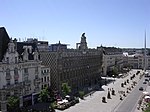Stade du Hainaut

Stade du Hainaut is a multi-use stadium in Valenciennes, France. It is used mostly for football matches and hosts the home matches of Valenciennes FC. It has replaced the Stade Nungesser as VAFC's home stadium. The stadium has a capacity of 25,172 spectators for football matches, but its capacity can be extended to 35,000 for concerts. The stadium is one of the venues for the 2019 FIFA Women's World Cup. It hosted 4 group games, a Round of 16 match, and a quarter-final match. The stadium was constructed at a total cost of 75 million euros. It contains 2,600 club seats and 16 luxury boxes. It has two giant video screens, each 48 square meters in size. Its roof contains 1,800 tons of steel.
Excerpt from the Wikipedia article Stade du Hainaut (License: CC BY-SA 3.0, Authors, Images).Stade du Hainaut
Avenue des Sports, Valenciennes
Geographical coordinates (GPS) Address Nearby Places Show on map
Geographical coordinates (GPS)
| Latitude | Longitude |
|---|---|
| N 50.348388888889 ° | E 3.5316111111111 ° |
Address
Avenue des Sports
59300 Valenciennes, Faubourg de Cambrai
Hauts-de-France, France
Open on Google Maps









